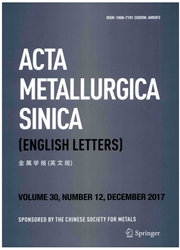

 中文摘要:
中文摘要:
在各种各样的温度的退火的 Intercritical (IA ) 由熄灭并且划分列在后面(IAQP ) 处理在滚动寒冷的 Fe0.2C1.42Si1.87Mn (wt%) 表钢上被进行。优化微观结构和提高的机械性质通过 IA 温度的适当调整被完成。在 1,033 点被退火的钢?为 600 的 K ? s ,然后熄灭了到 573 ? K 并且在 693 点划分了?为 20 的 K ? min ,指定了钢为 1033QP ,展览最大值 16.3 ?vol%与好机械性质保留了奥氏体( RA )(最终的张力的力量 886 ? MPa 和全部的延伸27%)。RA 的热、机械的稳定性被它的平均的碳内容的联合效果和邻近的马氏体的数量主要影响,这被发现。而且,导致转变的粘性效果增加了在 IAQP 钢变硬的工作的第二个阶段观察的山峰 n 值。
 英文摘要:
英文摘要:
Intercritical annealing(IA) at various temperatures followed by quenching and partitioning(IAQP) treatments was conducted on a cold-rolled Fe-0.2C-1.42Si-l.87Mn(wt%) sheet steel.Optimized microstructure and enhanced mechanical properties were achieved through appropriate adjustment of IA temperatures.The steel which was annealed at1,033 K for 600 s,then quenched to 573 K and partitioned at 693 K for 20 min,designated as 1033 QP steel,exhibits maximum 16.3 vol% retained austenite(RA) with good mechanical properties(ultimate tensile strength 886 MPa and total elongation 27%).It was found that the thermal and mechanical stabilities of RA are mainly influenced by the combined effect of its average carbon content and amount of adjacent martensite.Furthermore,the transformation-induced plasticity effect increased the peak n-values observed at the second stage of the work hardening of IAQP steels.
 同期刊论文项目
同期刊论文项目
 同项目期刊论文
同项目期刊论文
 Promoting martensitic transformation in Fe-Ni nanoparticles prepared by a Sol-gel and Reduction meth
Promoting martensitic transformation in Fe-Ni nanoparticles prepared by a Sol-gel and Reduction meth Austenite stability for quenching and partitioning treated steel revealed by colour tint-etching met
Austenite stability for quenching and partitioning treated steel revealed by colour tint-etching met Improved resistance to hydrogen embrittlement in a high-strength steel by quenching-partitioning-tem
Improved resistance to hydrogen embrittlement in a high-strength steel by quenching-partitioning-tem Origin of low-temperature shoulder internal friction peak of Snoek-K?ster peak in a medium carbon hi
Origin of low-temperature shoulder internal friction peak of Snoek-K?ster peak in a medium carbon hi Grain size dependence of the martensitic transformation in a nano-grained Fe-Ni polycrystal - A mole
Grain size dependence of the martensitic transformation in a nano-grained Fe-Ni polycrystal - A mole 期刊信息
期刊信息
